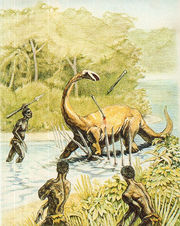
The mokele-mbembe, as pictured by David Miller on the cover of A Living Dinosaur? In Search of Mokele-Mbembe (1987), is probably the best known neodinosaurian cryptid.
Neodinosaurs or living dinosaurs are a category of cryptids including animals which are reportedly "remarkably dinosaurian in alleged appearance".[1] Sauropod dinosaurs are the most common kind of dinosaur compared to such cryptids, but neodinosaurs compared to ceratopsians, iguanodonts, and theropods have also been reported.[2] The most famous examples are those reported from Central Africa, such as the mokele-mbembe, emela-ntouka, and mbielu-mbielu-mbielu, but neodinosaurs have been reported, with varying degrees of frequency and plausibility, from every continent except Antarctica.[1] The term was coined by Ivan T. Sanderson in 1969.[3]
As neodinosaurs, especially long-necked types, are often reported from freshwater swamps, lakes, and rivers, the Coleman-Huyghe system of sea serpent and lake monster classification includes dinosauria as a type of aquatic cryptid. Although many of these cryptids are considered more likely to be undiscovered reptiles or mammals than living dinosaurs, the term neodinosaurs is often applied to them because of their at least superficial similarity to true dinosaurs, and because they are "so commonly aligned with [dinosaurs] in the cryptozoological literature".[2]
Neodinosaurs by geography[]
- Neodinosaurs in the Amazon Basin
- Neodinosaurs in Australia
- Neodinosaurs in Central America
- Neodinosaurs in Central and West Africa
- Neodinosaurs in China
- Neodinosaurs in New Guinea and the Bismarck Archipelago
- Neodinosaurs in North America
- Neodinosaurs in Southeast Asia
Notes and references[]
- ↑ 1.0 1.1 Shuker, Karl P. N. (2016) Still In Search Of Prehistoric Survivors: The Creatures That Time Forgot?, Coachwhip Publications, ISBN 978-1616463908
- ↑ 2.0 2.1 Shuker, Karl P. N. "Living Dinosaurs in Africa? Seeking the Mokele-Mbembe," Practical Reptile Keeping, No. 76 (July 2015)
- ↑ Heuvelmans, Bernard (1978) Les Derniers Dragons d'Afrique, Plon, ISBN 978-2259003872
